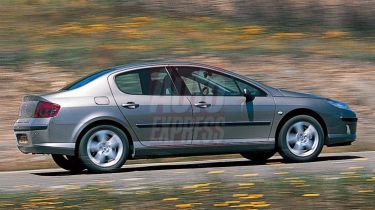Peugeot 407 HDi 136 SE
It may have taken a while to arrive, but the replacement for Peugeot's ancient 406 is finally here. And it's not only Lion fans who will raise an interested eyebrow, because if you find the Vauxhall Vectra or Ford Mondeo a little too ordinary, the new 407 could be exactly what you are looking for.
You'll either love or hate the styling, but no one can deny the 407 stands out. With a wide range of engines and trim levels, it should appeal to fleet and private buyers alike. Rear headroom is tight, but ride, handling and refinement impress. We'll be pitching the 407 against its rivals next month. The result will be interesting.
It may have taken a while to arrive, but the replacement for Peugeot's ancient 406 is finally here. And it's not only Lion fans who will raise an interested eyebrow, because if you find the Vauxhall Vectra or Ford Mondeo a little too ordinary, the new 407 could be exactly what you are looking for.
With its striking styling, the Peugeot certainly stands out from the motorway crowd. The huge slatted front grille has a certain Ferrari familiarity, although with a huge, steeply raked windscreen and a similar side profile, there's also a hint of the smaller 307. However, as an overall design, the 407 does seem a little awkward, with the massive front overhang the most obvious oddity.
While the exterior has been a talking point since the car was first revealed in December last year, now is the time to see if the driving experience will cause a stir, too. Sharing powerplants with Citroen's C5, the saloon comes with a familiar choice of engines. Most sales will come from the two diesels,a 110bhp 1.6 and 136bhp 2.0-litre. For the buyers who want petrol power, the units range from 1.8 to 3.0 litres.
Used - available now

2019 Ford
Fiesta Vignale
44,100 milesManualPetrol1.0L
Cash £10,500
2022 Volkswagen
ID.3
33,043 milesAutomaticElectric
Cash £13,500
2023 Audi
e-tron
50,934 milesAutomaticElectric
Cash £18,900
2022 Dacia
Duster
49,300 milesManualPetrol1.0L
Cash £11,100We tried the 136bhp 2.0-litre HDi, which is tipped to be the most popular model in the UK. The engine is still not the quietest at tickover, but it's refined on the move with plenty of low-down thrust. However, it's the 407's ride and handling that will really worry rivals. A new set-up means the car is exceptionally well poised through corners, with hot hatch levels of grip and excellent body control. While the electro-hydraulic steering doesn't provide a particularly sharp turn in, it is well weighted and communicative. Interestingly, there are three power-steering systems on offer, each tailored for particular models and engines. Most importantly, though, Peugeot has not abandoned its legendary ride quality, as the 407 soaks up rough surfaces with ease, yet manages to remain composed at speed. Add great noise insulation to the flexible diesel, and the 407 is an excellent motorway cruiser. Company buyers will also be pleased to hear both oil-burners are Euro IV-compliant, to ease the income tax burden. Inside, the old-fashioned 406 interior is consigned to the history books - the 407 has an airy ambience similar to that of the smaller 307.
Reach and rake wheel movement, plus a height-adjustable seat, make for a good driving position, and even though you sit a long way away from the windscreen, visibility is fine. The centre console houses the climate and audio con-trols, plus optional phone and sat-nav switches, but it's cluttered on high-spec models. Despite ignoring the trend towards hatches, Peugeot has ensured the 407 is practical; the rear seats split, fold and tumble to give a flat load area.
Unfortunately, rear passengers aren't as well catered for. While legroom is reasonable, that swooping roofline means headroom is tight. But one surefire way of attracting buyers away from rivals is to offer lots of standard kit. Even the base 407 has a CD player, seven airbags and climate and stability control, while there is a comprehensive range of options.







